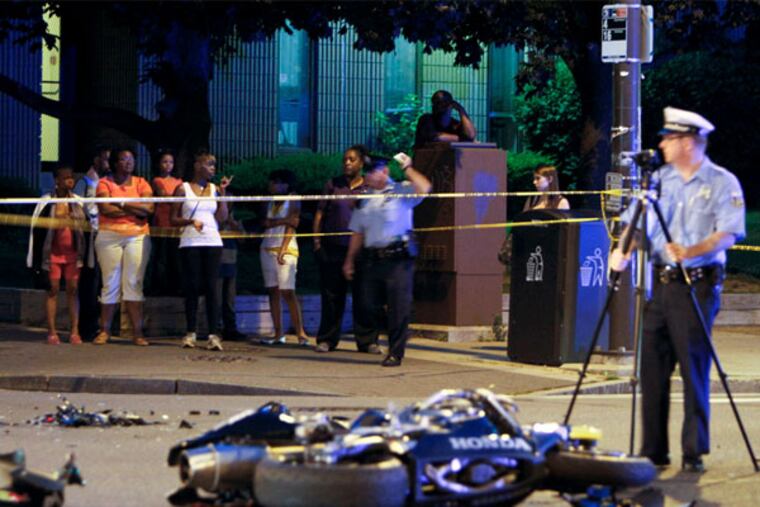How gas prices relate to motorcycle fatalities
While traffic fatalities have dropped to record lows in recent years, motorcycle deaths have risen, reflecting both an increase in the number of riders and the inherent vulnerability of the vehicles.

While traffic fatalities have dropped to record lows in recent years, motorcycle deaths have risen, reflecting both an increase in the number of riders and the inherent vulnerability of the vehicles.
And researchers have found a strong relationship between gasoline prices and motorcycle fatalities: As gas prices rise, so do the number of fatalities, and falling gas prices tend to be mirrored by reduced numbers of motorcycle deaths.
Safety experts speculate that is because higher gas prices encourage people to use fuel-efficient motorcycles instead of cars.
"Motorcycles are the highest-risk form of driving," said John Ulczycki, vice president of strategic initiatives for the National Safety Council. "They do not follow normal trends of highway fatalities because the circumstances that lead to motorcycle fatalities are somewhat different than automobile crashes."
In 1975, 44,525 people died in highway accidents in the United States. Of those, 3,189 were motorcyclists.
By 2012, total highway fatalities had dropped to 33,561, while motorcycle deaths rose to 4,957.
In Pennsylvania, motorcycle fatalities rose 43 percent between 2001 and 2013, while fatalities in other vehicles dropped 27 percent over the same period.
With millions more cars and motorcycles on the road now than 40 years ago, the fatality rate has dropped for both types of vehicles. But the decline has been much greater for cars: a threefold drop nationwide in the fatality rate for cars, compared with a 14 percent drop for motorcycles.
The difference, safety experts say, is that cars are much safer than they used to be, with seat belts, air bags, antilock brakes, electronic stability control, and other features.
"With motorcycles, there's not much you can do to improve safety. They're just out there, hanging on their own," said safety researcher James Hedlund, who studies motorcycle accidents for the Governors Highway Safety Association, which represents the highway safety offices of the states.
"The best thing you can do is wear a helmet, and helmet use has gone down over the past 30 years," Hedlund said.
In 1975, 47 states required all motorcyclists to wear helmets, but that number has dropped to 19 now.
New Jersey requires helmets, while Pennsylvania repealed its mandatory helmet law in 2003 and now requires helmets only for those under age 21 or licensed for less than two years, unless they have completed an approved safety course.
The National Highway Traffic Safety Administration estimated that helmets saved 1,617 motorcyclists' lives in 2011 and would have saved 703 additional lives if all motorcyclists wore helmets.
Dave Moore, who owns a Honda motorcycle dealership in Lancaster and is a past president of the Pennsylvania Motorcycle Dealers Association, said distracted driving by motorists has likely contributed to motorcycle accidents.
"We're much more invisible than a car," Moore said, "so people talking on cellphones or texting really affects us."
An analysis by the National Safety Council showed a strong correlation between gasoline prices and motorcycle fatalities, charting the trend since 1976.
"There is definitely a trend with new unit sales when gas prices go up," said Pete terHorst, spokesman for the American Motorcyclist Association. He said that could mean "more people and potentially more inexperienced riders" on the road.
"I suspect we get back in our pickup trucks when prices go down," Moore said. "We do see kind of a frenzy in the dealership when gas approaches $5 a gallon."
A report last year by Hedlund for the Governors Highway Safety Association recommended ways to reduce motorcycle fatalities:
Increase helmet use. The U.S. Government Accountability Office concluded in 2012, after reviewing safety studies, that "laws requiring all motorcyclists to wear helmets are the only strategy proven to be effective in reducing fatalities."
Reduce drunken riding. In 2010, 29 percent of fatally injured riders had a blood alcohol concentration at or above the legal limit of 0.08 percent, the highest among all motorists.
Reduce speeding. According to the most recent data, 35 percent of motorcycle riders involved in fatal crashes were speeding, and almost half of these crashes did not involve another vehicle.
Improve training. While all states offer training, some courses may not be provided at locations and times convenient for riders.
Encourage all drivers to share the road. According to NHTSA, when motorcycles crash with other vehicles, the other vehicle usually violated the motorcyclist's right of way.